The article An Examination of New Product Development Best Practice from Journal of Product Innovation Management has great best practice AND benchmarking information for all R&D organizations. The authors of the article conducted a survey of 286 companies across USA and Europe. The objective was to understand what best practices are implemented, what best practices are not implemented and what practices are understood to be poor (Please note, the article uses NPD for New Product Development):
..it is unclear whether NPD practitioners as a group (not just researchers) are knowledgeable about what represents a NPD best practice. The importance of this is that it offers insight into how NPD practitioners are translating potential NPD knowledge into actual NPD practice. In other words, are practitioners aware of and able to implement NPD best practices designated by noteworthy studies? The answer to this question ascertains a current state of the field toward understanding NPD best practice and the maturity level of various practices. Answering this question further contributes to our understanding of the diffusion of NPD best practices knowledge by NPD professionals, possibly identifying gaps between prescribed and actual practice.
The article divides R&D into seven dimensions and looks into best practices for each. Let us dig in:
1. Strategy: Strategic alignment for R&D was considered the most important dimension of the seven considered. The article defines strategy as everything from vision definition to prioritization of projects for resource allocation.
strategy involves the defining and planning of a vision and focus for research and development (R&D), technology management, and product development efforts at the SBU, division, product line, and/or individual project levels, including the identification, prioritization, selection, and resource support of preferred projects.
Within Strategy, most organizations aligned R&D to long-term company strategy and project goals seemed to be aligned well with the organization / mission. Also, organizations were able to redirect projects as markets changed. Here is the list of implemented best practices (again NPD=R&D):
- Clearly defined and organizationally visible NPD goals
- The organization views NPD as a long-term strategy
- NPD goals are clearly aligned with organization mission and strategic plan
- NPD projects and programs are reviewed on a regular basis
- Opportunity identification is ongoing and can redirect the strategic plan real time to respond to market forces and new technologies
R&D
Some of the best practices that clearly did not get implemented deal with pet projects and managing R&D projects as portfolio. Organizations did not have portfolio management processes implemented or they did not treat R&D projects as a portfolio (each was unique and not measured with respect to others. We have quite a bit of information about R&D portfolio management here.
2. Market Research: Understanding of customer/market needs and having them drive the R&D process was the second most dimension of R&D management.
describes the application of methodologies and techniques to sense, learn about, and understand customers, competitors, and macro-environmental forces in the marketplace (e.g., focus groups, mail surveys, electronic surveys, and ethnographic study).
Within market research, the best practices were pretty straight forward: Use customer research to drive product development. Also involve customer in testing the products at multiple stages of product development.
- Ongoing market research is used to anticipate/identify future customer needs and problems
- Concept, product, and market testing is consistently undertaken and expected with all NPD projects
- Customer/user is an integral part of the NPD process
Results of testing (concept, product, and market) are formally evaluated
We have discussed customer driven R&D in the past. We have also discussed that over dependence on customer can actually be harmful to R&D. We have also seen Steve Jobs talk about user centric design, he did not directly involve customers in many stages of R&D. For revolutionary products, customers are unlikely to be a good driver for R&D.
3. Product Launch: Processes associated with product commercialization / launch were rated the third most important area for best practices.
Commercialization describes activities related to the marketing, launch, and postlaunch management of new products that stimulate customer adoption and market diffusion.
Bar was not very high relative to launch related processes. Most involved having a process, following it and tracking / learning from results.
- A launch process exists
- The launch team is cross-functional in nature
- A project postmortem meeting is held after the new product is launched
- Logistics and marketing work closely together on new product launch
- Customer service and support are part of the launch team
Product launch processes are quite important and we have discussed the impact of corporate cultures on
new product launches. The key poor practice identified was keeping product launches secret to prevent unauthorized public announcement. Not sure if that can be helped.
4. Processes: The article refers to stage gate reviews and knowledge management as key processes for R&D:
Within this framework, NPD process is defined as the implementation of product development stages and gates for moving products from concept to launch, coupled with those activities and systems that facilitate knowledge management for product development projects and the product development process.
It appears that most organizations recognized the need to have common processes for R&D: Stage gates, clear go/no-go criteria and well documented processes existed.
- A common NPD process cuts across organizational groups
- Go/no-go criteria are clear and predefined for each review gate
- The NPD process is flexible and adaptable to meet the needs, size, and risk of individual projects
- The NPD process is visible and well documented
The NPD process can be circumvented without management approval
The key poor practices seem to be about inadequate IT tool support, uneven access to R&D knowledge and poor implementation of project management practices. May we suggest InspiRD?
5. Company Culture: The next highly rated dimension of R&D management was company culture, its acceptance of R&D management as an important constituent and ability for R&D teams to collaborate across disciplines and organizations/suppliers:
company culture is defined as the company management value system driving those means and ways that underlie and establish product development thinking and product development collaboration with external partners, including customers and suppliers. Characteristics of company culture include the level of managerial support for NPD, sources used for NPD ideas, and if creativity is rewarded and encouraged.
The key complaint about company culture was a rejection of external or disruptive ideas. We have discussed this extensively.
6. R&D Climate: This dimension relates to R&D project organization (such as cross functional teams) including leadership and HR support.
Within this framework, project climate is defined as the means and ways that underlie and establish product development intra-company integration at the individual and team levels, including the leading, motivating, managing, and structuring of individual and team human resources.
The best practices are straight forward – cross functional teams and multiple means of inter/intra team communications.
- Cross-functional teams underlie the NPD process
- NPD activities between functional areas are coordinated through formal and informal communication
We have discussed project networks as a way to supplement cross-functional teams. A key challenge seems to be the inability to gain support for ideas that cross functions. Also, knowledge transfer across disciplines is also a major challenge.
7. R&D Metrics: Although metrics was rated the least important area for R&D management, the authors rightly point out that it is because very few meaningful R&D-related metrics exist.
The metrics and performance measurement dimension of the framework includes the measurement, tracking, and reporting of product development project and product development program performance.
In fact, participants could not point out a single best practice for R&D metrics! We have discussed plenty of interesting metrics.




